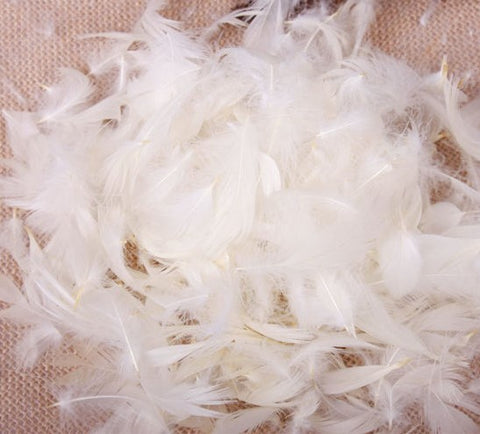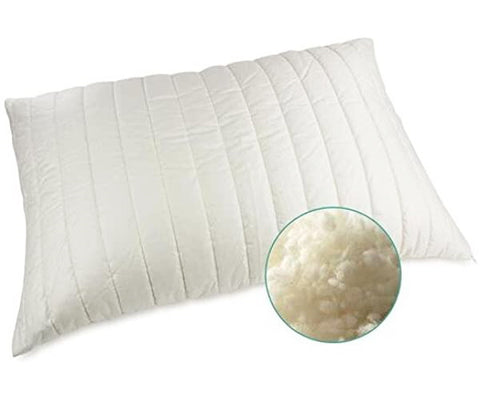When we experience sleep issues or want to improve sleep quality, the first thing that comes to mind is probably finding a good, comfortable mattress. However, did you know that choosing the right pillow can be just as important to getting restful sleep?
With so many pillow options available, shopping for a new pillow can be overwhelming. But through this guide, we’ve put together everything you need to know to find the perfect pillow for you and your loved ones!

Pillow Buying Guide: Section Guide
When should I replace my pillow?
What types of pillows are there?1. Natural Pillow Fillings
a) Down Pillows
b) Feather Pillows
c) Wool Pillows
2. Synthetic Fillings
a) Microfibre (Down-Alternative) Pillows
b) Memory Foam Pillows
c) Latex Pillows
i) Natural Latex Pillows
ii) Synthetic Latex Pillows
iii) Blended Latex Pillows
Which pillow should I choose for my sleeping position?
Back Sleepers
Side Sleepers
Stomach Sleepers
Combination Sleepers
Pairing your pillow with your mattress
Other things to look for in a good pillow
a) Customer Reviews
b) Quality Standards
c) Cooling Properties
d) Adjustability
e) Home Trial and Returns Policy
f) Pillow Warranty
Why the right pillow is so important for you
How to sleep better with Skyler Pillows
Skyler Contour Pillow
Skyler Classic Pillow
When should I replace my pillow?
The lifespan of pillows depend on the materials they’re made of and how well they’ve been maintained, but they should generally be replaced every 18-24 months, or when you notice significant signs of wear and tear such as sagging, lumps, odours, or the inability to retain its original shape after use.
Many people might be unaware that issues such as waking up with constant neck or spinal pains can be resolved by simply replacing an unsupportive pillow that’s past its prime. Moreover, as pillows are known to accumulate dead skin cells and dust mites which can cause allergies, people who suffer from allergies should consider replacing their pillows more regularly.
Below is a list of average lifespans for different types of pillows:
| Pillow Type | Lifespan |
| Down Pillow | 3-5 years |
| Latex Pillow | 3-5 years |
| Memory Foam Pillow | 1-3 years |
| Feather Pillow | 1-3 years |
| Wool Pillow | 1-2 years |
| Microfibre (Down-Alternative) Pillow | 1-2 years |
What types of pillows are there?
Pillows are available in a variety of materials and fillings which affects their firmness, comfort and support levels. Pillows are generally made from either natural or synthetic materials, each of which have their own advantages and are suited for a particular sleep preference, such as price, durability, a softer or firmer feel, or whether they are suitable for people prone to allergies.
1. Natural Pillow Fillings
Natural fillings are generally lightweight and breathable. If you prefer a pillow with a softer, responsive feel, a pillow with a natural fill would be a good match for you. These are the most common pillows made with natural fillings:
a) Down Pillows
Down pillows are made from quill-less feather clusters of the chest and underbelly of geese and ducks. The fill is very lightweight and extremely soft, which allows the pillows to feel cuddly, breathable and malleable. Down pillows are also relatively expensive compared to pillows made from other materials. In general, the higher the amount of fill in down pillows, the more loft (pillow height) and firmness you will get, and the pricier they become.

| Pros | Cons |
|
|
b) Feather Pillows (Feather and Down Blends)
Feather pillows are made from the feathers from the wings and the back of birds. As feather-only pillows tend to feel slightly rough, their fillings are usually mixed with down to improve overall softness and comfort. Feather pillows are similar to down pillows in terms of comfort and breathability, but they are significantly cheaper. Some users may also complain about the stronger odour from feather pillows compared to down.

| Pros | Cons |
|
|
c) Wool Pillows
This natural fiber is grown on sheep. It provides firm support and durability, and effectively helps regulate body temperature. However, over time, the wool filling may clump into balls, resulting in an uneven pillow surface.

2. Synthetic Fillings
Pillows made using synthetic fillings are available in a variety of shapes and styles. They are versatile and can provide additional support, making them suitable for a wide range of sleep positions. They are generally less expensive than pillows made with natural fillings and are suitable for people who may be allergic to natural fillings such as down. Below are some of the most popular pillow types and explore to see what option fits you best:
a) Microfibre (Down-Alternative) Pillows
Microfibres are synthetic fibres made from polyester. Pillows that use microfibre fillings are extremely popular as they are lightweight, soft, easy to clean, and most importantly, inexpensive. They provide a similar feeling to fluffy down pillows and are a good alternative for people who are affected by allergies, and thus are often called “Down-Alternative” pillows. Although microfibre pillows are a good value proposition for many, their lifespan is comparatively short and would typically need to be replaced every 1-2 years. With continued usage, microfibre pillows tend to flatten and lose support over time.

| Pros | Cons |
|
|
b) Memory Foam Pillows
Memory foam is made from viscoelastic polyurethane and was originally invented by NASA for the comfort and safety of astronauts. Its responsiveness allows the pillow to conform to your head and neck while you sleep, providing dynamic support whenever you reposition and evenly distributes the weight of your head, reducing strain on your neck and back.

| Pros | Cons |
|
|
c) Latex Pillows
Latex pillows are similar to memory foam pillows where they can provide excellent comfort and support to the neck and head. Latex can be either natural or synthetic, with some pillows blending the two.
i) Natural Latex Pillows:
Natural latex pillows are made using latex rubber harvested from rubber trees, which are chemical-free and have minimal smell. These pillows are also naturally hypoallergenic and are resistant to dust-mites and mould. They can provide very responsive support to the head and neck, are highly breathable, and are very durable. However, natural latex pillows often cost much higher than other types of pillows, including those made with synthetic or blended latex.

ii) Synthetic Latex Pillows:
Synthetic latex is a man-made version of natural latex and they are made using Styrene-Butadiene Rubber (SBR). Synthetic latex pillows are usually cheaper than natural latex pillows and blended latex pillows. They feel similar to natural latex pillows, but may give off a chemical odour. They are also known to retain heat more easily than natural latex and are less durable.
iii) Blended Latex Pillows:
Blended latex foam is produced from a blend of natural and synthetic latex, typically comprising 15-25% natural latex and the remainder being synthetic latex. Blended latex pillows feel more similar to natural latex pillows, are less likely to have off-gassing compared to synthetic latex due to the fewer chemicals used, and are typically less expensive than natural latex options.
Which pillow should I choose for my sleeping position?
When choosing a pillow, it is important to consider your regular sleep position as it will influence the level of support you require from your pillow to ensure proper alignment of your head, neck and shoulders.
Back Sleepers

When sleeping on your back, a pillow should support the natural curvature of your head, neck and shoulders. We recommend a medium to medium-soft pillow for an optimal level of support and to keep your neck and spine in a neutral position.
We recommend: Memory foam or microfibre (Down-alternative) pillows
Pillows to avoid: Thick and lofty pillows, or fluffy and soft pillows
Side Sleepers

For side sleepers, we recommend choosing a medium-firm or firm pillow, and with a higher height than pillows for back sleepers. A thicker layer of support is required to align your head, neck and spine horizontally when you’re lying on your side.
We recommend: Latex, memory foam or thicker microfibre (down-alternative) pillows
Pillows to avoid: Fluffy down, feather and down-alternative pillows
Stomach Sleepers

Sleeping on your stomach is considered one of the worst positions for spinal alignment as it can potentially block airways and make it difficult to breathe throughout the night. For this position, we recommend using a soft, flat and breathable pillow. You can also place another relatively flat pillow under your stomach while you sleep to help your spine keep its natural alignment.
We recommend: Soft down, feather or wool pillows
Pillows to avoid: Thick and lofty pillows
Combination Sleepers
For combination sleepers who often change their sleep positions throughout the night, a medium to medium-firm pillow would be ideal. These pillows can provide sufficient support when lying on your side, while also being comfortable and soft enough for back and stomach sleep positions.
We recommend: Memory foam, latex, or firmer microfibre (down-alternative) pillows
Pillows to avoid: Fluffy down, feather and down-alternative pillows
Pairing your pillow with your mattress
We hope that you’ve now got a better idea on what types of pillows are available and which are best suited for your sleep position. However, for the optimal sleep experience, it is important to pair your pillows with a suitable mattress to ensure proper alignment between your head, shoulders and spine.
As a general rule, regardless of whether you sleep on your side, back or stomach, if you have a firmer mattress, you should choose a fuller pillow. If you have a softer mattress, you should go for a thinner pillow. A softer mattress typically allows your body to sink in more, so there’s less of a gap to fill between your head and the mattress, and thus a thinner pillow would be more suitable.
On the other hand, using a pillow that’s already past its prime or unsuitable for your sleep position won’t be able to properly support your head, and may lead to neck or spinal issues, even if you’re using a brand-new, good quality mattress.

Other things to look for in a good pillow
Apart from your sleeping positions and preferences, there are also other important factors that you should consider when choosing your perfect pillow.
a) Customer Reviews
We recommend reading through customer reviews to help you understand first-hand what others’ experience has been with their purchase, giving you further insight on aspects of the service and product that might not be mentioned elsewhere. Online retailers typically allow their customers to leave feedback on their purchase and have reviews available for browsing on their websites, increasing transparency and guiding you towards making an informed purchase.
b) Quality Standards
Choose pillows which are made with high quality materials that meet international certifications such as CertiPUR-US® for foam, and OEKO-TEX® for textile materials. This ensures your pillow meets the required performance standards and does not possess any health risks.

c) Cooling Properties
Pillows can vary in terms of their breathability and cooling properties. If you tend to sleep warm, look for pillow fillings that allow air to flow through such as microfibre, down / feathers, latex or foam chunks. Memory foam pillows can trap heat, though many contain cooling gel or other cooling materials that counteracts this tendency. Similarly, also look for breathable materials used in the pillow’s outer cover.
d) Adjustability
Some modern pillows allow users to adjust or change the filling to the needs of the sleeper. You can add more filling or additional padding to make the pillow firmer or higher, or reduce the filling to make it lie flatter against your mattress. This is a useful feature to have and reduces the likelihood where the pillow’s height or firmness isn’t suitable for your preferences.
e) Home Trial and Returns Policy
When buying a pillow, you may never know if it fits your needs without trying it out for a few nights. Consider whether a home trial and refund policy is offered with your pillow, so you can test out the pillow at home for a period of time to properly evaluate whether it’s the right one for you.
f) Pillow Warranty
After making your purchase, you’d want to be sure that your pillow comes free of any issues. The warranty period and coverage offered with pillows can vary depending on the brand and pillow type. While most policies cover defects in materials or workmanship, some also offer coverage on sagging or loss of support.
Caring for your pillow
For your pillows to last for as long as possible, it is important to take good care of them. While many people would regularly change their pillowcases, they often forget that their pillow also needs regular cleaning from time to time, particularly as pillows are likely used in very close contact with their face. Over time, pillows can accumulate sweat, body oils, saliva and dust mites, and thus it is necessary to keep them as clean as possible.
We highly recommend using a pillow protector or cover (in addition to your pillowcase) for all-round protection against liquids, dust mites and allergens, particularly for people who are more sensitive to allergies.
Many pillows are machine washable, while some can only be dry-cleaned. Other types of pillows such as memory foam pillows cannot be machine washed, but often come with a separate cover that can be taken off to be washed. We recommend washing your pillow at least two times a year, and do check your pillow’s care label for wash instructions.

| Pillow Type | Care Instructions |
| Down / Feather / Microfibre (Down-Alternative) |
|
| Memory Foam / Latex |
|
| Wool |
|
Why the right pillow is so important for you
When you think of quality sleep, the first product that comes to mind is probably the mattress. Pillows, on the other hand, are often overlooked, but their role in helping us sleep is just as important. They help support your upper body while you sleep and keep your spine in a neutral alignment. When choosing your pillow, consider your sleep position and firmness of your mattress to find one that suits you best. Once you’ve found the right pillow for yourself, you’ll notice significant improvements to your sleep quality.
How to sleep better with Skyler Pillows
We’ve designed the Skyler pillows to help you sleep better, with versatility to suit different sleep positions, and using premium memory foam which contours to the shape of your head, relieving pressure and offering proper support to your neck, shoulders and back.

Our pillows are also topped with a cooling gel pad layer and a Coolmax® & Tencel® blended cover to provide excellent airflow and effectively disperse heat so you can always sleep cool, even on warm nights. Removable foam layers added to our pillows gives you the option to adjust the pillow height to your own preference, and a washable cover ensures your pillow can always be kept clean.
What’s more, we offer a 30-night trial for our pillow products which guarantees that if you don’t like your pillows, you can return them for a full refund. A 3-year warranty is also included with all pillows. No risk, no worries!
Skyler Memory Foam Pillow - Contour Pillow
If you’re looking for additional support for your neck and shoulders, or are experiencing neck pains, our Contour Pillow would be a great choice! Its ergonomic shape cradles around your neck and shoulders, relieving pressure and allowing your muscles to relax as you sleep. The Contour pillow also comes with an additional foam layer which can be added or removed to adjust the height of the pillow to suit your preferences.

Highlights:
- Ergonomic shape for additional neck and shoulder support
- Can help relieve chronic neck or back pain
- Infused cooling gel pad
- Height adjustable
- Removable and washable pillow cover
- Heat-dissipating and moisture-wicking
- Anti-bacterial and dust-mite resistant
- Suitable for side and back sleepers
Skyler Memory Foam Pillow - Classic Pillow
If you tend to change positions as you sleep, or prefer a more traditional pillow shape, our Classic Pillow is for you. Its flat-profile surface provides balanced support for your head and neck, which can prevent a stiff neck while you move around the pillow at night. The Classic pillow is designed with a firmer, cooling gel layer on one side and softer memory foam on the other side, and can be used on both sides according to your preferences.

Highlights:
- Balanced support for your head and neck
- Infused cooling gel pad
- Double-sided use
- Removable and washable pillow cover
- Heat-dissipating and moisture-wicking
- Anti-bacterial and dust-mite resistant
- Suitable for all sleep positions




